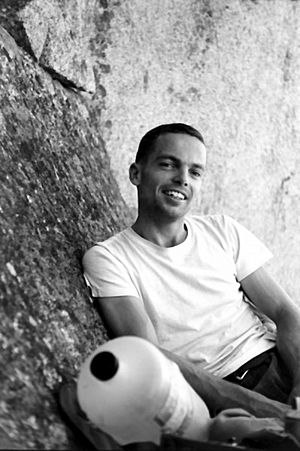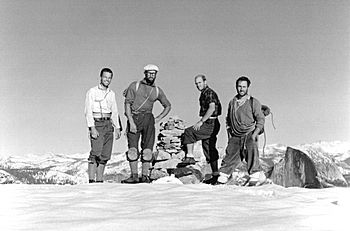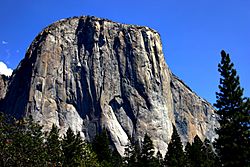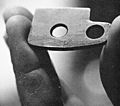Tom Frost facts for kids

Thomas "Tom" M. Frost (born June 30, 1936 – died August 24, 2018) was an American rock climber. He was famous for being the first to climb many "big wall" routes in Yosemite Valley. He was also a talented photographer and made special climbing gear. Tom Frost was born in Hollywood, California, and passed away in Oakdale, California.
Contents
Tom Frost's Amazing Climbs
Tom Frost grew up in Newport, California. As a teenager, he was a champion sailor, winning the Snipe National Championship in 1953 and 1954.
In 1958, he finished his engineering degree at Stanford University. He was part of the Stanford Alpine Club, which is a group for mountain lovers.
Tom started making "first ascents" in Yosemite in 1958. A first ascent means being the first person to successfully climb a route. In 1960, he made the second climb of The Nose on El Capitan. This huge rock face is in Yosemite Valley. He climbed with Royal Robbins, Chuck Pratt, and Joe Fitschen.

In 1961, Tom Frost and Yvon Chouinard visited the Tetons. They were the first to climb the northeast face of Disappointment Peak. This climb was very hard, rated IV, 5.9, A3 on the Yosemite Decimal System (YDS).
On September 12, 1961, Frost and Robbins began the first climb of the Salathé Wall on El Capitan. This route was named after a famous Yosemite climber, John Salathé. They spent two days climbing the first 600 feet. Then they went back down to get more supplies. They met up with Chuck Pratt and spent more days climbing another 400 feet.
On September 19, they started climbing again. After many days of hard "aid climbing" (using gear to help them go up), they reached a tricky spot called the Roof. It was a 15-foot overhang. Tom Frost led this part, using special metal pegs called pitons. On September 24, the three climbers reached the top! It took them 11 days and 36 sections of climbing. The route is rated YDS VI, 5.10, A3, showing how difficult it was.
In 1963, he went to the Himalaya with Edmund Hillary. They made the first climb of Kangtega. Tom also helped build a school and a hospital for the Sherpa people there.

From October 22 to 31, 1964, Tom Frost, with Robbins, Pratt, and Chouinard, made the first climb of the North America Wall on El Capitan. This climb was rated YDS VI, 5.8, A5. Royal Robbins said this climb was a big step forward. They learned that their bodies and minds could get used to living and working on a vertical wall. This was the first time an El Capitan climb was done in one continuous push.
In 1968, Frost visited the Cirque of the Unclimbables in Canada. From August 10 to 13, he, Jim McCarthy, and Sandy Bill were the first to climb the vertical southeast face of the Lotus Flower Tower. This 2,200-foot granite pillar was a YDS V, 5.8, A2 climb.
In 1970, he joined the Annapurna South Face expedition. He reached a height of 25,000 feet on the mountain.
In 1979, he reached the top of Ama Dablam while on a filming trip.
In 1986, he went back to Kangtega and climbed a new route with Jeff Lowe.
From 1997 to 2001, he returned to Yosemite's big walls with his son, Ryan. They repeated the Nose, the North America Wall, and the Salathé Wall. This last climb was on the 40th anniversary of his first ascent of the Salathé Wall.
Tom Frost's Key First Ascents
- 1961 Salathé Wall, El Capitan, Yosemite Valley, California, US. This was the hardest big wall climb (Grade VI) in the world at that time. He climbed it with Royal Robbins and Chuck Pratt.
- 1962 Northeast Face, Disappointment Peak, Teton Range, Wyoming (IV 5.9 A3). He made this first ascent with Yvon Chouinard.
- 1964 North American Wall, El Capitan, Yosemite Valley (VI 5.8 A5 3000'). This was a first ascent with Royal Robbins, Yvon Chouinard, and Chuck Pratt.
Tom Frost's Photography
Tom Frost took many pictures during his first climbs. Glen Denny, another climbing photographer, said that Frost's photos were special. He took them during major first ascents, not just set-up shots. Even in tough conditions like heat, cold, storms, or fear, he managed to take amazing pictures.
Some of Frost's photos were in Royal Robbins' book, Advanced Rockcraft, in 1973. He also took many photos for Yvon Chouinard's book Climbing Ice. Nine of his pictures were in the book Fifty Classic Climbs of North America. Many more appeared in Pat Ament's book Royal Robbins: Spirit of the Age.
In 1979, he started a company called Chimera Photographic Lighting with Gary Regester. This company, based in Boulder, Colorado, makes lighting products for photography and filming.
Tom Frost's Climbing Ideas and Activism
Tom Frost always believed in being kind to nature while climbing. He tried to use natural ways to protect himself whenever possible. He wanted to "leave no trace" that he had been there. He shared his ideas at a meeting in Austria in 2002.
He didn't like it when some climbers used too many bolts, especially on old routes that had been climbed without them. He felt this showed a desire for "instant fun with little or no responsibility." He said that "selfishness," "feeling like you deserve things," "not managing yourself," "bad education," and "disrespect" were problems in modern climbing.
Starting in 1997, Frost played a big part in stopping the National Park Service from building dorms near Camp 4. This is a historic campsite for climbers in Yosemite Valley. He argued that the buildings would ruin the camp's natural feel. With help from others, Frost sued the Park Service. The American Alpine Club also joined the lawsuit.
To help save Camp 4, Frost and his lawyer also asked for Camp 4 to be listed on the National Register of Historic Places. This list protects important historical places. The park officials finally agreed to stop the building plans and supported the application. Camp 4 was added to the list in 2003. It was recognized for its important role in the history of rock climbing in Yosemite during its "golden years."
In 2002, Royal Robbins described Tom Frost as "the kindest and gentlest and most generous person I have ever met." He also called him a "man of courage and leadership" for his work to save Camp 4.
Tom Frost's Climbing Gear Inventions
While climbing Kat Pinnacle with Chouinard in 1959, they designed and made a tiny device called the Realized Ultimate Reality Piton (RURP). This small tool helped them finish the hardest aid climb in North America at that time. This led to a long partnership between Frost and Chouinard in climbing equipment companies. Tom Frost even called himself a "piton engineer."
In the late 1960s, Frost and Chouinard started looking at ice climbing gear. They created an ice axe with a special curved pick. They also began selling adjustable rigid crampons made of strong steel in 1967. These were special spikes that climbers wear on their boots for ice.
Frost and Chouinard also invented a climbing protection device called the Hexentric. They got a patent for it in 1976. These Hexentrics are still made today by Black Diamond Equipment, a company that came from Frost and Chouinard's earlier businesses.
Since 1997, Tom Frost owned his own business called Frostworks, which made rock climbing equipment.
Gallery of Tom Frost photos
-
Nobel Prize–winning physicist Henry Kendall
-
Chuck Pratt resting on El Capitan
-
Rock climber Royal Robbins on El Capitan
-
Rock climber Royal Robbins











